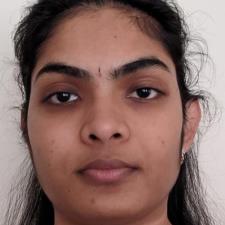
Genesis O.
asked • 09/05/23Unions and Intersections
Let S be the universal set, where:
S={1,2,3,...,18,19,20}=
Let sets A and B be subsets of S, where:
Set A={2,3,4,5,10,13,18}
Set B={2,7,10,12,13,14,15,17}
Set C={4,5,7,14,19}
LIST the elements in the set (A∪B∪C)
(A∪B∪C) =
LIST the elements in the set (A∩B∩C)
(A∩B∩C)=
Enter the elements as a list, separated by commas. If the result is the empty set, enter DNE
2 Answers By Expert Tutors
Set A={2,3,4,5,10,13,18}
Set B={2,7,10,12,13,14,15,17}
Set C={4,5,7,14,19}
Copy down the elements (members) of the first set.
{2,3,4,5,10,13,18}
Go through the second set and mark out any elements that are not also in the second set.
{2,10,13}
3, 4 , 5, and 18 are not in the second set, so remove them from the new set. 7, 12, 24. 15, and 17 are in the second set, but not the first, so don't write them down.
Now go to the third set. Remove any elements that are not in both sets. This eliminates all members. So the set is empty, {}. The solution does not exist. So DNE.
NOTE that the intersection set contains only the members in all three sets. In this case, there are no such elements.
☆☆☆☆☆☆☆☆☆
For the set union, just collect all the members of the three sets, and remove any duplicates so that you don't repeat any members.

Madhuri P. answered • 09/05/23
Expert Math tutor | Statistics Grad
For A∪B∪C,
- first list all the elements in A {2,3,4,5,10,13,18}
- Now go through each element in B and see if it is already in A. If it is not already in A, then add to the list. For example 2 is already in the list but not 7.
- Then A∪B = {2,3,4,5,7,10,12,13,14,15,17,18}
- Similarly, go through each element in C and see which element does not exist in A∪B. The only element to add will be 19. Therefore A∪BUC = {2,3,4,5,7,10,12,13,14,15,17,18, 19}
Can you use the same logic to find out the elements which are present in all of A, B and C to get A∩B∩C ?
Still looking for help? Get the right answer, fast.
Get a free answer to a quick problem.
Most questions answered within 4 hours.
OR
Choose an expert and meet online. No packages or subscriptions, pay only for the time you need.






Mark M.
Do you have a question about union and intersection?09/05/23